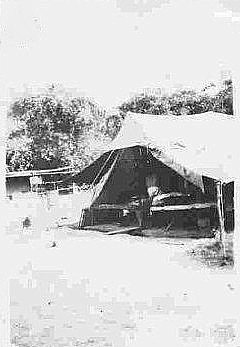Library Reference Number: 075
1354 DDT Flight, Pegu, Burma

 With World War 2 in the Far East drawing to a close, various organisations were working behind the scenes and drawing up plans on
measures to improve the health and conditions of the world's populations. So, on 15th October 1945, I and my other crewmembers found
ourselves flying over the Bengal Sea in a Liberator posted from No.355 Squadron, Salbani, India, to 1354 DDT Flight, Pegu, Burma.
This Unit was formed to carry out spraying DDT operations from the air over parts of the then countries of Burma, Siam and
Indo-China, to combat and destroy the malarial-carrying mosquito and its breeding grounds.
With World War 2 in the Far East drawing to a close, various organisations were working behind the scenes and drawing up plans on
measures to improve the health and conditions of the world's populations. So, on 15th October 1945, I and my other crewmembers found
ourselves flying over the Bengal Sea in a Liberator posted from No.355 Squadron, Salbani, India, to 1354 DDT Flight, Pegu, Burma.
This Unit was formed to carry out spraying DDT operations from the air over parts of the then countries of Burma, Siam and
Indo-China, to combat and destroy the malarial-carrying mosquito and its breeding grounds.
Pegu is about 100 miles north of Rangoon, the base a few miles from Pegu, hacked out of the jungle. Tented accommodation was provided in a clearing and was basic in the extreme. Decidedly hot and very humid, all kinds of insects and reptiles were in abundance; mosquitoes, snakes and scorpions were very much in evidence.
Fresh water contained in barrels was brought in daily. Meals, often just a box of emergency rations, was your lot! It was then back to the tent and depend on the Char Wallah. Compulsory at dinnertime in the mess was the issue of a tot of rum, and the taking of two mepacrin tablets to combat malaria, all these measures supervised by the Duty Officer. That for us was the base, together with the other crews assigned to spraying duties. Other personnel included crews from 1348 Air Sea Rescue Flight, flying Lancaster's with under slung lifeboats. Also present were personnel employed in the Control Tower, maintenance crews, administration, catering and other essential staff.
 In terrain so recently claimed from the jungle, it was necessary to have a metal runway and taxiways. The elevation was 150 feet
above sea level, this displayed on the jungle control tower.
In terrain so recently claimed from the jungle, it was necessary to have a metal runway and taxiways. The elevation was 150 feet
above sea level, this displayed on the jungle control tower.
 The Liberators allocated to 1354 DDT Flight were easily adapted to take the system needed to spray DDT. Two thousand gallons of DDT
fluid were filled into the ex-bomb bay overload fuel tanks. Fluid was then fed by gravity through pipes leading to a collector tank.
This was fitted to the position normally taken up by the ball turret, and using the same hydraulic system to lower and raise the
collector tank. Two outlet pipes from the collector tank were fitted with outlet valves, which in turn were operated through a
system of wires from the nose compartment. This allowed the fluid to flow out and be vaporised by the slipstream, and down onto the
spray area allocated by the Health Organisation.
The Liberators allocated to 1354 DDT Flight were easily adapted to take the system needed to spray DDT. Two thousand gallons of DDT
fluid were filled into the ex-bomb bay overload fuel tanks. Fluid was then fed by gravity through pipes leading to a collector tank.
This was fitted to the position normally taken up by the ball turret, and using the same hydraulic system to lower and raise the
collector tank. Two outlet pipes from the collector tank were fitted with outlet valves, which in turn were operated through a
system of wires from the nose compartment. This allowed the fluid to flow out and be vaporised by the slipstream, and down onto the
spray area allocated by the Health Organisation.
1354 DDT Flight was commanded by Squadron Leader P. Sandell, with four crews of 5 members each - Pilot, 2nd Pilot, Navigator, Flight Engineer, and Wireless Operator.
Depending on the area to be sprayed, take-off was such that spraying had to be undertaken before the heat of the day. For Indo-China, take-off was 03.00 Hours. Siam: take-off 06.00 Hours. Rangoon and Burma area: 07.30 Hrs.
Once the spray area was identified, spraying was carried out at 300 feet in a creeping search pattern with the Engineer operating the collector tank and the Navigator operating the outlet valves from the nose compartment as each run over the spray area was started and finished. Flights to and from Saigon, Indo-China lasted about nine hours; Bangkok (Siam) about six hours; and Rangoon area about three hours.
In Siam, we were not allowed to overfly the King's Palace, so had to make a quick bank to avoid the Palace as it was very close to one of the spray areas. Similarly with the Golden Pagoda at Rangoon. The Flight was disbanded on 13th February 1946, and we were posted to No. 1347 Air Sea Rescue Flight at Chittagong, India - but that is another story.

